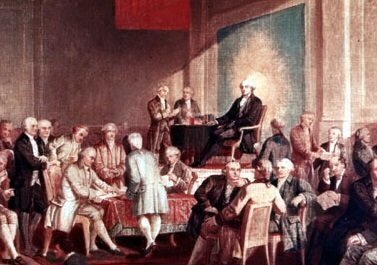In 1787, the Founding Fathers proposed a new Constitution that profoundly changed America. But did you know some residents of Pennsylvania and New York were given versions of the Constitution that differed from the one approved in Philadelphia?
 A new study from four researchers picks apart the German- and Dutch-language printed versions of the Constitution that were provided to residents of the two states as the adoption of the founding document was publicly debated.
A new study from four researchers picks apart the German- and Dutch-language printed versions of the Constitution that were provided to residents of the two states as the adoption of the founding document was publicly debated.
Christina Mulligan, Michael Douma, Hans Lind and Brian Quinn examined the rare documents, which were originally printed in 1787 and 1788, and later republished in collected volumes.
“The translations also provide evidence of the original public meaning of the U.S. Constitution, as reflected in the translators’ interpretive choices and in how the translations would have been understood by Dutch and German speakers,” the authors state.
One week after the Constitutional Convention approved a document on September 17, 1787, the Pennsylvania Assembly ordered 3,000 versions printed in English and 1,500 printed in German, and the documents distributed to the public. At the time, about 37 percent of Pennsylvania’s population was German in origin. The authors stated that Michael Billmeyer was hired to print the German-language version, but the translator wasn’t named.
The Dutch version was created and printed in 1788 at the request of pro-Federalist groups who wanted residents in the Albany area, who spoke Dutch, to have access to the Constitution during the pitched public debate in New York state. The translator was a minister, Lambertus de Ronde, and the printer, Charles Webster, owned the Albany Gazette and Albany Journal.
The Dutch-language version may have impressed older leaders in upper New York, but the region was carried by the anti-Federalists, who opposed the Constitution, in the state delegation voting process.
So how do the two documents differ from the standard English-language Constitution that was circulated among the residents of other states in the late 1780s?
One issue, the authors identify, is the ability of the unknown German translator and de Ronde to understand the native language equivalents of English words that had a precise legal meaning. Another is that the translators made simple mistakes. And in some cases, the translators used English words in the translations when there wasn’t a native-language alternative.
“Discovering a slippage of meaning in the translation of the English to the Dutch or German versions is just half the battle; a researcher would need to analyze the original public meaning of the Dutch or German terms of interest as well, requiring specialized knowledge and research,” the authors say.
Still, the differences in translation offer a unique look at how Dutch and German speakers were presented with some concepts, in a way that varied from the English version of the Constitution.
For example, there are different versions of the Commerce Clause in Article 1, Section 8, of the Constitution. The German version uses a word to define “commerce” that indicates “the larger scope of actions and interactions of persons involved in business.” The Dutch version defines commerce as activities among merchants.
The authors also argue that German translation “appears to allow the government to establish commerce where it might not have previously existed,” which would have made an interesting argument as part of the 2012 Supreme Court decision over the Affordable Care Act.
They also believe that a strict interpretation of the German and Dutch words used for the Necessary and Proper Clause in Article 1 (which directs Congress to make laws needed for the country’s good) would restrict some powers of Congress in passing “sweeping laws.”
In an appendix that accompanies the research, a quick look shows some interesting word choices from the two translators.
For instance, amendments to the Constitution are called “improvements” in the German translation. The Dutch version considers felonies to be “crimes worthy of death,” while the German translation considers felonies to be serious crimes.
The term “high crimes and misdemeanors” in the Impeachment Clause have different meanings in the Dutch and German translations. The word “misdemeanors” is translated to misconduct or misdeeds. And the word “trial” is translated to “interrogation” in German.
As a bonus, the authors include an 1807 translation of the Bill of Rights into German to illustrate other cultural differences.
In the Second Amendment, the right “to keep and bear arms” is translated as the right “to carry arms.” And in the Fifth Amendment, the words “criminal case” are translated to the words “painful case,” a stricter definition based in Latin.
Scott Bomboy is the editor-in-chief of the National Constitution Center.







